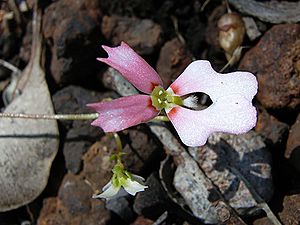Book triggerplant facts for kids
Quick facts for kids Book triggerplant |
|
|---|---|
 |
|
| Scientific classification | |
| Genus: |
Stylidium
|
| Species: |
calcaratum
|
| Synonyms | |
|
Candollea calcarata (R.Br.) F.Muell. |
|
The book triggerplant, also known as Stylidium calcaratum, is a fascinating small plant. It belongs to a special group of plants called dicotyledons. This plant is part of the Stylidium genus, which is known for its unique "trigger" mechanism.
The book triggerplant is an annual plant. This means it grows, flowers, and produces seeds all within one year, then dies. It is also an ephemeral plant, meaning it lives for a very short time. Usually, it grows to be about 5 to 10 centimeters (2 to 4 inches) tall. However, in damp forests or wet areas, it can grow much taller, up to 20–30 centimeters (8–12 inches).
Its leaves are small and oval-shaped. They grow in a circle, like a rosette, at the base of the stem. These leaves are only about 3–5 millimeters long. The plant's flower stalks, called scapes, can be anywhere from 2 to 30 centimeters tall. Smaller plants might have just one flower, while larger, stronger plants can have up to nine flowers.
The flowers are usually pink or white. They often have red spots or lines at the base of each petal. A cool thing about these flowers is how their petals are arranged. They are paired vertically and can fold over. This happens at night or when the weather is bad.
Contents
Where Does the Book Triggerplant Live?
The book triggerplant is endemic to Australia. This means it is found naturally only in Australia. Its range stretches from Victoria through South Australia and into Western Australia. You can often find it growing in wet, flat areas. It also likes to grow near creeks and places where water seeps out of the ground.
How Does It Get Pollinated?
Pollination is how plants reproduce. For the book triggerplant, a special grey fly helps with this process. This fly is called Comptosia cuneata. When the fly visits the flower, it helps to move pollen from one flower to another. This allows the plant to make seeds and grow new plants.
Naming the Book Triggerplant
The book triggerplant was first officially described in 1810. A famous botanist named Robert Brown gave it its scientific name. He wrote about it in his book, Prodromus Florae Novae Hollandiae et Insulae Van Diemen.
Later, other scientists also described this plant. In 1839, John Lindley called it Stylidium androsaceum. Then, in 1845, Otto Wilhelm Sonder named it Stylidium lindleyanum. However, it was later decided that these were all the same plant. So, Robert Brown's original name, Stylidium calcaratum, is the one used today.
A Special Variety
In 1956, two botanists, Rica Erickson and Jim Willis, described a special type of this plant. They called it Stylidium calcaratum var. ecorne. This variety was different because it didn't have a nectar spur. It also grew in pure groups, meaning only that variety was found there.
Later, in 1979, other scientists decided this variety was unique enough to be its own species. They gave it a new name, S. ecorne. This shows how scientists learn more about plants over time.

